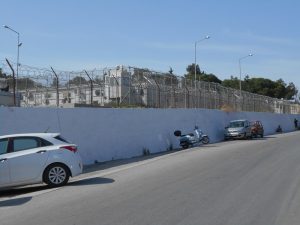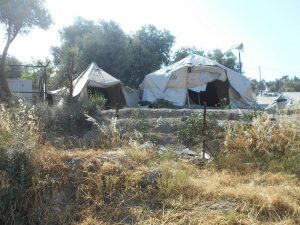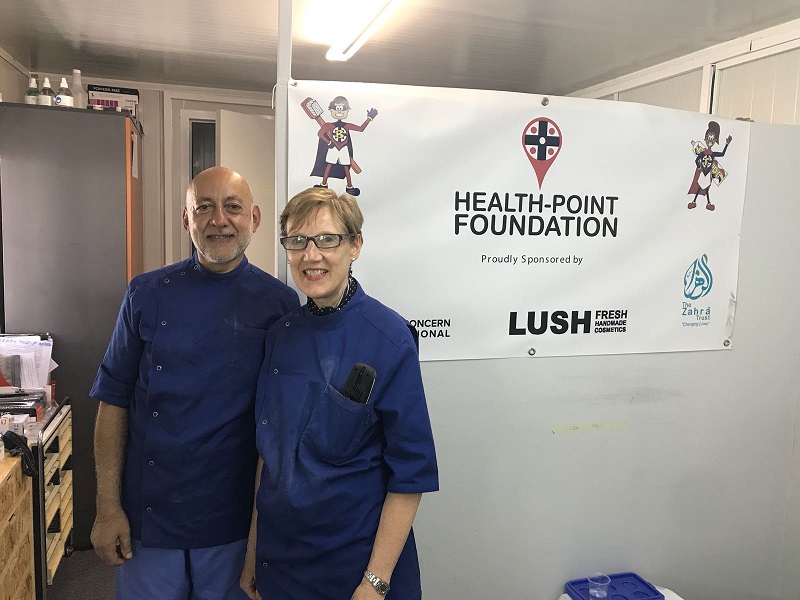In the first of two articles, the second will follow next week, dentist and Rye resident Kyriacos Hajikakou shares his experience of volunteering among refugees in Greece.
At the beginning of June, I went to the Greek island of Lesbos to continue the work I have been doing for the past two years – offering emergency dental treatment to refugees. It was my sixth trip and as on five of the past occasions Diana, my wife, came with me to assist.
Readers of Rye News who have read the previous articles will know that I am with an organisation called Heath Point Foundation (HPF) which was previously based in Thessaloniki in Northern Greece. HPF, a very small charity, felt that although there was a great need for their work in northern Greece, the need in Lesbos was even more urgent.
Until March of this year there was no dental provision at all so HPF transferred (after a great deal of wrangling with the local health authorities) and are now based at the Moria refugee camp near Mytilini, the largest town in Lesbos.
Moria is in a former army camp and it was set up about five years ago to house some 2,000 people on a temporary basis. There are now about 8,000 people in the camp, but the number is difficult to quantify as it grows daily.
Refugees make the perilous crossing from Turkey on a daily basis but the numbers arriving exceed those leaving the camp for their onward trip to Athens. As a result the camp gets more and more crowded, the facilities do not expand in line with the increasing arrivals so the camp becomes ever more squalid and the air of desperation is palpable.
Four families share tents roughly divided with blankets strung up to make “rooms”. Those in an Isobox (like a Portacabin) are better off than those in tents, but find that the electricity supply is intermittent and unreliable, and there can be as many at 25 young single men sharing the accommodation.

Early on the morning of our first working day we caught the bus for the 15-minute journey to the camp from our base in Mytilini and used the bus every morning to get to Moria camp. There is a good service running every 30 minutes from 7am to 10:30pm and is much used by the camp’s inhabitants.
After an inital period of about a month, the time taken to register new arrivals, those living in the camp are free to come and go as they please. On previous trips we’d had to drive to a different location every day, sometimes for as long as two hours, to set up a temporary clinic so being in the same place each day was a new experience.
Moria camp looks forbidding. There are two rows of wire each one topped with razor wire, and there is a checkpoint manned by police and each morning we had to show our documentation. The setting of the camp is idyllically placed among the olive groves that abound on this beautiful island.
Near the entrance enterprising locals have set up makeshift cafes, while fruit and vegetables can be bought from the back of vans and inside the camp we saw ad hoc stalls selling old clothes, cooking utensils or hot drinks – unfortunately very sugary in the Arabic fashion.
We walked through the busy and crowded camp to find the dental clinic. It is housed in an Isobox and has two dental chairs with the mobile dental units which were partly funded by generous donations from Rye residents.
We were taken aback to find that we were inside a wire cage with an extra double row of wire topped with razor wire and a guard at the gate. We shared our compound with other small charities eg European Lawyers in Lesbos, the Boat Refugee Foundation and a Spanish ocular charity.
The camp is currently run by UNHCR but they are threatening to pull out and hand the camp over to the already hard-pressed local government. Other large, well-known charities have already left the camp as they disapprove of the way refugees are dealt with on a national and EU basis as well as locally.
This has had the effect of reducing the services available in the camp, leaving everything to small charities which do what they can but aren’t able to cope with the enormous demand. MSF (Médecins Sans Frontières) is no longer in Moria but has a large tent opposite to the camp entrance.
Each morning Giorgos, the guard on at the compound gate, greeted us with a cheery: “Welcome to hell.” We got talking to him and found that he had a degree, had worked as a journalist for many years but the dire ecomomic situation in Greece meant that the only work available was as a security guard at 500 euros per month.
He told us that in the spring of 2016 there had been some high-profile visitors to Moria, namely Angelina Jolie and the Pope. This had generated much publicity about the plight of the refugees but it had also alerted potential tourists and in the summer of 2016 the numbers of visitors plummeted, leading to resentment among those whose livelihood is dependent on tourism.
Giorgos asked us to tell people we met that Lesbos is beautiful (it is) and that it would be an excellent destination for those seeking the usual delights of a Greek island. Although we didn’t get the chance to travel around this charming place we would stress that we felt perfectly safe and would be happy to agree that it would make a splendid holiday destination.

I would estimate that I was able to assist about 85% of those patients who came to consult me, but it’s the ones I couldn’t assist that haunt me. Most of the patients needed fillings or extractions though many patients requiring extractions refused this option (as I have found before).
Instead they chose the first part of a root treatment even though it was explained that our clinic could not complete the procedure and that they would definitely need further treatment to ensure remaining pain free. Some patients needed referral to an oral surgeon, for example a young man who’d had a motor cycle accident before leaving Syria, or those needing complex wisdom tooth removal.
One man came with an x-ray taken in Turkey which showed that he had an ectopic tooth near his sinus. Previously symptomless it was now causing him pain but was beyond the capability of our clinic to deal with. Mytilini hospital, however, has no oral surgery department.
This information was conveyed by a letter written in Greek and given to a patient whom HPF had previously referred. I was able to read the letter and convey this dispiriting information. So there was literally nothing I could offer these patients apart from pain killers – a pitiful stopgap that I found difficult to cope with.
Another patient needed a biopsy – he was an elderly man with no teeth who now had pain which prevented him from eating and he was in despair. Such cases are enough to drive one to tears and at one point Diana did indeed break down with the sadness of it all, but sobbing in a corner does nothing to help those waiting outside in the lengthy queue. One has to be brisk, pull oneself together and get on with it and this is what Diana managed to do.
One patient who comes to mind is a young pregnant woman with an abscess that rendered her unable to open her mouth properly and whose eye was closed and swollen with the infection. The best thing to do was to incise the swelling to allow the pus to drain out.
She accepted this less than pleasant experience with equanimity whereas the strapping chap from the Congo in the same situation made a huge fuss, shouting and trying to get out of the chair so that I was unable to do the procedure properly for him. This young woman was in such good health that the incision healed up but it had helped her so much that she returned a couple of days later for the process to be repeated.
I saw a couple of young Syrian women, sisters-in-law, who were very nervous and reluctant to accept treatment (fillings) at first but they gathered their courage and I was able to treat them. I was very heartened that they returned the following day for more treatment and on the second occasion were much more relaxed. I found this a rewarding experience, and our time in Moria wasn’t all doom and gloom.
Kyriacos’ moving account of volunteering at the Moria refugee camp will continue in next week’s edition of Rye News
Photos: Kyriacos Hajikakou



